Jordan River Valley
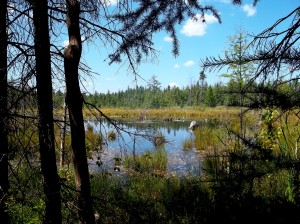 Just north of Mancelona in Antrim County lies a truly wild area. A total of 18,000 acres of floodplain, forests, river valley and a sizable hill with a story of its own makes this a must see for any hiker in Northern Michigan. Called the Jordan River Valley this area is home to a variety of animals and habitats, the Jordan River, a designated Wild and Scenic River and Deadman’s Hill.
Just north of Mancelona in Antrim County lies a truly wild area. A total of 18,000 acres of floodplain, forests, river valley and a sizable hill with a story of its own makes this a must see for any hiker in Northern Michigan. Called the Jordan River Valley this area is home to a variety of animals and habitats, the Jordan River, a designated Wild and Scenic River and Deadman’s Hill.
Officially Michigan’s first waterway to be designated a Wild and Scenic River, visitors who make their way down Deadman’s Hill to the bottom are privy to freshwater aquifer bubbling up from the ground, strange plants and grasses and a variety of animals including beavers, bears, many bird spaces as well as snakes, frogs and a variety of other water related species.
This first time I did the short loop, a three mile loop trail which makes its way down Deadmans Hill, to the river and then back up, I was surprised at the beauty of not just the top of the hill but the valley as well. Upon arrival to the river, we stepped out into what appeared to be more of a jungle than a river valley in Northern Michigan. Grasses which stood over 8 feet tall towered over our heads waving in the wind. We pushed our way through until it opened up into the valley itself and in a crystal clear pool of water to my right, a beaver swam under the water away from the sound of our footstep.In places where the trail was wet, if you stopped to listen, you could hear why. Springs of fresh water bubble out of the ground and create little streams and creeks which meet up with the Jordan River as it makes its way out of the Valley and off to Lake Charlevoix.
For the real adventurer that is looking for a longer hike, the Jordan Valley Pathway which includes part of the 3 mile short trail, runs a full 18 miles, 9 miles in and 9 miles out. A campground at the end of the 9 miles offers hikers a perfect place to enjoy spending a night in the wilderness of Northern Michigan. Part of this trail actually shares its path with the North Country National Scenic Trail, a trail which is yet to be completely finished but is slated to be a total of 4,000 miles from North Dakota to New York when it is done.
I went back to this trail some 10 years since the last time I hiked it and enjoyed the second trip just as much as the first. The wildlife, the serenity and the views are unequaled from most of the places I have been too in Michigan.
Notes: Camping in the area is only allowed in designated areas. Be sure to stop by the Jordan River National Fish Hatchery while you are visiting, its just down the road. Fall is a great time to see some amazing colors. Spring is a great time for beautiful flowers but expect some flooding. Summer is just incredibly pleasant.
Tahquamenon Falls – A Fall Adventure
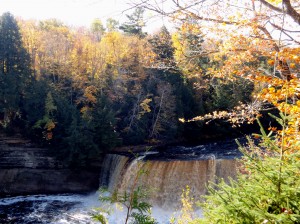 It has been well over 10 years since I have set foot at our largest Michigan waterfall. This past weekend we took our first trek to this popular Northern Michigan destination in over a decade. Nestled way up in the Upper Peninsula in a town called Paradise, this stunning Northern Michigan State Park is more crowded than any state park I have ever visited in Michigan. There were easily over 1,000 or more people visiting at the same time as we were. The paths at the Upper Falls were crowded with people and other dogs. We saw a number of people from other countries visiting as well, a welcome but unexpected experience.
It has been well over 10 years since I have set foot at our largest Michigan waterfall. This past weekend we took our first trek to this popular Northern Michigan destination in over a decade. Nestled way up in the Upper Peninsula in a town called Paradise, this stunning Northern Michigan State Park is more crowded than any state park I have ever visited in Michigan. There were easily over 1,000 or more people visiting at the same time as we were. The paths at the Upper Falls were crowded with people and other dogs. We saw a number of people from other countries visiting as well, a welcome but unexpected experience.
The Upper Falls are the most popular part of the park and for good reason. The largest falls in the state of Michigan, they plunge nearly 50 feet and are a full 200 feet across, making them one of the largest falls north of the Mississippi. The Lower Falls of the park have a separate entrance just up the road a bit. Visitors have the opportunity to hike the 4 miles along the river as well, presenting a unique and closer look at the mighty Tahquamenon River.
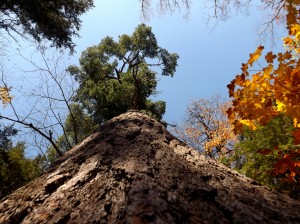 Our journey may have begun in the most crowded part of the park however, the moment we stepped onto the Big Pines Trail just past the Upper Falls viewing area, we were on our own. The colors were spectacular and although the trail (over 3 miles) got a bit muddy at times, the views were stunning and so were the trees. The Big Pines Trail is so named not for the number of pines on the trail, but for the size of the 2 largest. Mostly made up of Hemlock, other wetland conifers as well as birch, maple and oak, the two big pines on the trail were the biggest we had ever seen. Over 5 feet in diameter and well over 100+ feet tall, these massive White Pines illustrate well what made them so demanded during the logging era. A welcome surprise for me especially, this trail offered a much different look at what Tahquamenon Falls State Park has to offer then I remembered.
Our journey may have begun in the most crowded part of the park however, the moment we stepped onto the Big Pines Trail just past the Upper Falls viewing area, we were on our own. The colors were spectacular and although the trail (over 3 miles) got a bit muddy at times, the views were stunning and so were the trees. The Big Pines Trail is so named not for the number of pines on the trail, but for the size of the 2 largest. Mostly made up of Hemlock, other wetland conifers as well as birch, maple and oak, the two big pines on the trail were the biggest we had ever seen. Over 5 feet in diameter and well over 100+ feet tall, these massive White Pines illustrate well what made them so demanded during the logging era. A welcome surprise for me especially, this trail offered a much different look at what Tahquamenon Falls State Park has to offer then I remembered.
The Lower Falls were another beautiful part of the trip. Here, visitors have the opportunity to rent a boat for as long as they want and row around within a designated area by the Lower Falls. The Lower Falls are also the location of the campground as well and we happened to be there during their Harvest festival and were met by hundreds of little visitors dressed in costume out enjoying this beautiful fall day.
Another unexpected perk of our trip was the Tahquamenon Falls Restaurant and Brewery. The beer was wonderful, the food was tasty and aside from the wait, I had no complaints. We spent some of our time sitting outside on the porch with dozens of others with our beer, enjoying the warm sunny fall day until our name was called and can’t think of a better place to wait.
All in all, aside from the crowds, which I am sure could have been, at least in part avoided if we had visited on a weekday, this park did not let us down. Beautiful, educational and tasty, I recommend that everyone see this lovely park. Visit the Upper and Lower Falls as well as the bar/restaurant, but get out on a trail and see the other natural areas as well.
Note: This park was dog friendly. Dogs are welcome on the trails as long as they are on a 6 foot leash and under your control.
A Journey Into The Pines
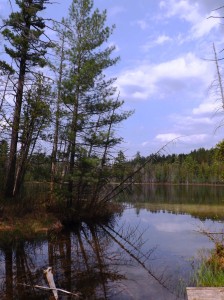 Michigan is home to more than 100 state parks, over 130 state forest campgrounds and 17 harbors, all of which offer ample opportunities for us to get out and enjoy the beauty of our Great Lakes State. From lakes and streams to sand dunes to forests, there are thousands of unqiue and beautiufl destiantions througout the upper and lower peninsula.
Michigan is home to more than 100 state parks, over 130 state forest campgrounds and 17 harbors, all of which offer ample opportunities for us to get out and enjoy the beauty of our Great Lakes State. From lakes and streams to sand dunes to forests, there are thousands of unqiue and beautiufl destiantions througout the upper and lower peninsula.
Parks are a funny thing. If you have ever spent time, or perhaps worked at a park, they become like your own. Those of us who have been lucky enough to have happy childhood memories of camping or hiking in a state park or wonderful and beautiufl memories of being able to make a living and educate the public working at a state park, you likely understand. It is this inate love of “your” park that makes it difficult to choose the “best” park in the state. while each offers its own unqiue and special features, there is one park that is hands down, the best park in our state, welcome to Hartiwick Pines State Park.
A run down of the basics are as follows:
Hartwick Pines State Park began its life in recent history as the perfect place for some outstanding timber for the Salling Hanson Lumber Company. While much of the land was logged and in fact, an old railroad, 100 year old stumps and archelaogical eveidence of camps can still be found in the park today, Karen Hartwick recognized the beauty of the area and preserved the land. In 1933, Karen Hartwick, the wife of Major Edward Hartwick, donated 8,236 acres of land including 4 lakes and over 90 acres of old growth white pines, to the state in his memory. Today the park encompasses around 15 miles of land (9672 acres) and a remaining stand of around 40 acres of old growth white pine which stands some 130 to 170 feet tall and is estimated to be around 350 to 450 years old.
All facts aside, what makes this park amazing may begin with its place in our country’s history and include the pines and how old they are, but those really are just the facts. What really makes this park amazing is the way it sounds on a warm summer day as you sit and relax in the forest, the buzz of the cicadas, the see see see suzeee of the black throuated green warblers a hundred feet above you, the wind whispering throught the pines elliciting an almost “waterfall” quality and then there is the smell. The smell of the hundreds of years of pine needles and leaves baking in what little sun does reach the ground in the dense forest, the smell of amazing and unique wildflowers such as the trailing arbutus which blooms in spring. It may be small, but the first time you bend down and put your face in this little flower, you will understand what makes this a flower that will keep you coming back year after year.
There really is not enough time to say what makes this park so special. Yes its festivals, and there are four, are enjoyable and very informative, and yes, the old growth trail and the visitor center are a must see for their information and historic importance as well as their beauty, and yes the logging museum will teach you a thing or two. The park is all these things, but it is much more. Hartwick Pines State Park is magical. It is filled with plants and animals, some of which are threatened, endangered or extirpated from our state. It is filled with smells,tastes and feelings which transport the daydreamers to a time that has long since passed. It is home to lakes, rivers, wetlands, forests both pine and leafed, and best of all, for those who know and love it, it is filled with memories.
Take a walk on one of its hiking trails, there are three. Go for a bike ride through the woods, there are 15 miles. Ski or snowshoe in winter. Find out more about the history or even the bog. Go for a scenic drive, its 7 miles. Have a picnic, camp or just relax and enjoy one of Michigan’s best state parks.
Hartwick Pines State Park is located just outside of Grayling Michigan at exit 259 off of I-75. Open year round, take advantage of all the seasons. Find out for yourself what makes Hartwick Pines State Park, the best park in Michigan.
“Our ability to perceive quality in nature begins, as in art, with the pretty. It expands through successive stages of the beautiful to values as yet uncaptured by language.”
― Aldo Leopold, A Sand County Almanac: With Other Essays on Conservation from Round River
Shipwreck Tours In Alpena
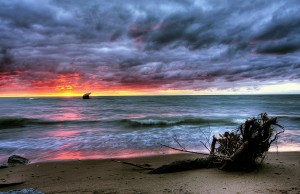 It’s funny how you can live near a place for your whole life and never even realize what you are missing. Nowhere was this more obvious to me than when we packed a cooler and headed to Alpena for a shipwreck tour.
It’s funny how you can live near a place for your whole life and never even realize what you are missing. Nowhere was this more obvious to me than when we packed a cooler and headed to Alpena for a shipwreck tour.
For many of us, when we think of shipwrecks, images of Goonies or even Swiss Family Robinson pop into our heads. For later generations, Pirates of the Caribbean and Johnny Depp may come to mind; and while the Great Lakes may not be known for pirates, shipwrecks abound especially in the “boneyard” found right here along the Northeastern coast of Michigan.
Alpena Shipwreck Tours The Legends of Thunder Bay, offers visitors a unique way to explore the history of the Great Lakes of the area. Two hour tours of Thunder Bay allow you to stare down through the glass viewing area in the bottom of a boat to the depths below and see the remains of some of the hundreds of shipwrecks caused by man and nature throughout the area. The tour itself allows you to relax and enjoy the beauty of our great lakes from above board where a guide introduces you to the area and its history. Upon reaching the marked sites which have buoys attached at each one as a mooring site for others, visitors head downstairs to take a look as the ship passes over the wreck below. The tour continues to a couple more sites around the bay which is referred to as the “boneyard”, until the ride back to port. Highlights of the tour include the history of the area shipwrecks, the beautiful weather and stunning views and for the kids and the kids at heart, the shipwrecks of course.
The tours begin from the Shipwreck Museum which is located in the National Marine Sanctuary. Considered one of the most treacherous stretches of water in the Great Lakes, “shipwreck alley”, as it is referred is home to around 200 of the best preserved shipwrecks in America. The preserve itself is 448 square miles and is home to over 100 shipwrecks which are considered historically significant. Created in 2000, the preserve and the Maritime Heritage Center are definite must sees for anyone who enjoys Great Lakes history and the Great Lakes themselves.
Alpena is a considered a commercial and cultural hub in this area of Northeastern Michigan. Home to between 10,000 and 12,000 residents, the city swells with visitors in the summer months. Founded in the late 1800’s Alpena was a boom town much like the other small towns. However, thanks to its location on the Bay, unlike other towns of its era, Alpena continued to grow and today survives in part to the Lafarge cement plant and the Besser Company, but increasingly due to tourism.
If you are interested in learning more about this Michigan Journey, visit them here: www.alpenashipwrecktours.com